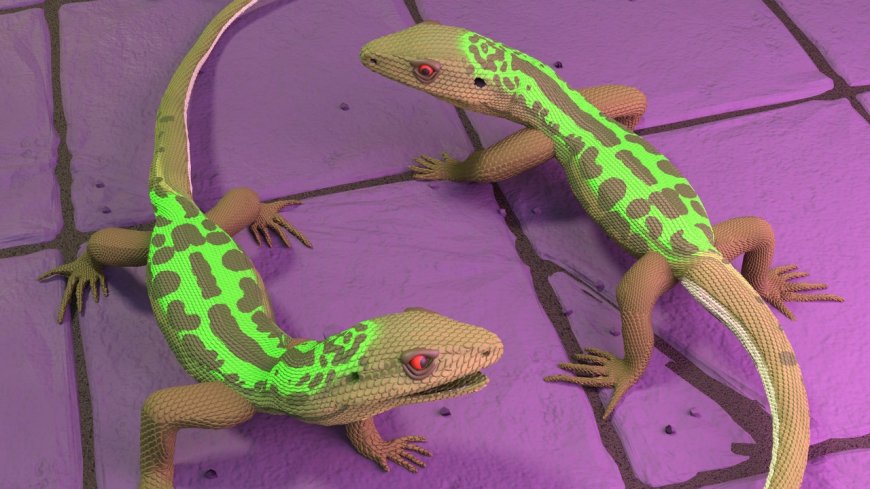The Lizard King of Long Island
The Weekend EssayJon Sperling secretly spread a non-native species across the Northeast. “It’s insane what this guy was doing,” a biologist said.By Ben GoldfarbNovember 16, 2024Play/Pause ButtonPauseIllustration by Arif QaziThe Italian wall lizard—a cigar-size Mediterranean reptile with a green back, mottled copper flanks, and a whiplike tail—is more or less the animal you picture when someone says the word “lizard.” Their ubiquity in places like Pompeii and the Colosseum has earned them the moniker “ruin lizards.” Their known range extends to Slovenia, Croatia, and, since the nineteen-sixties, Long Island, which they may have colonized after making their way out of a Hempstead pet store. Podarcis siculus thrived in the urban wilds of Garden City, feasting on spiders and crickets and sheltering in sidewalk cracks. By the two-thousands, according to one Hofstra University biologist, the area had become home to tens of thousands of the creatures. The New York Lizards, a now-defunct Major League Lacrosse team, adopted a large-eyed lizard as its mascot.Italian wall lizards have also spread. They have popped up in Pelham Bay Park, in the Bronx; Cypress Hills National Cemetery, on the border of Brooklyn and Queens; and the Baker Athletics Complex, at the northern tip of Manhattan. In 2014, a Greenwich resident reported a sighting on the Facebook page of Connecticut’s environmental-protection agency. The post inspired Colin Donihue, then a Ph.D. student studying lizard evolution at Yale, to visit Greenwich and, in newspapers and on his Web site, solicit more observations from the public. In 2016, he learned that wall lizards were living in Fenway Victory Gardens, in Boston, where they likely overwintered in the heat of compost piles—Fenway’s second-most-famous green monsters. “They can make a lot of different habitats work for them,” Donihue told me. “They’re pretty adapted to living alongside humans.”One of the people who chronicled this reptilian diaspora was me. On a summer afternoon in 2015, I was roaming around Hastings-on-Hudson, the Westchester village where I’d grown up, when my eye was drawn to movement atop a cobblestone wall: a lizard, the first I’d seen in Hastings. The creature posed for a photo, its scales glowing pewter and emerald in the sun. I texted the picture to Donihue, whom I happened to know, and to a biologist named Max Lambert. Donihue called a moment later. “I’ll be there tomorrow,” he said.The next morning, Donihue, Lambert, and I found lizards galore in the garden alongside the wall—basking on boulders, skittering through ivy, popping out of crevices. Donihue produced a fishing pole outfitted with a string lasso and, after two hours of pursuit, captured an adult female. “Ah, the sweet smell of lizard crap,” he said, as the writhing animal defecated on his hands. “The smell of victory.” The lizard—the northernmost member of its species recorded in the state of New York—was euthanized and added to the collection of the Yale Peabody Museum. A year later, we published our findings in a journal called Herpetological Review.Although we had documented the wall lizard’s spread, we hadn’t explained it. The eggs of Dactyloidae—lizards known as anoles—sometimes travel in potting soil, but we had no evidence of that here. Perhaps the reptiles had commuted along the Metro-North Railroad, whose rocky track bed was rife with hidey-holes. But that hypothesis was unsatisfying, too. Why were lizards in Hastings but not Dobbs Ferry, in Greenwich but not Stamford? Their origins, I assumed, would remain a mystery.Then, in March, 2024, nearly nine years after my discovery, Rachel Sperling, a social-science librarian at Yale, sent me an e-mail that, in the niche world of reptile biology, constituted a bombshell. Her late father, a longtime Queens College professor of biology named Jon Sperling, had played an active role in the lizard’s spread. Sperling had been “enchanted” with the lizards for decades, Rachel wrote, and had “made it his secret mission to help them branch out from Long Island to points north.” I would soon learn that he had captured, bred, and released them, but had never recorded his activities, aware that they were “ethically a bit dubious.” But he’d given his children permission to go public after he passed away—which he had, two months before, at eighty-seven.I had many questions. Had a herpetological Johnny Appleseed brought Italian wall lizards to my home town? Where else had he spread them, and with what consequences? I tried to imagine why a biologist, of all people, would spend years cultivating and distributing a non-native species. “It’s insane what this guy was doing,” James Stroud, an evolutionary biologist at Georgia Tech who has studied non-native lizards, told me when I related the story. “I’ve never heard anything like it.”Few forces have transformed our planet as thoroughly as the introduction of invasive species. The National Wildlife Federation notes that invasives are “amo

The Italian wall lizard—a cigar-size Mediterranean reptile with a green back, mottled copper flanks, and a whiplike tail—is more or less the animal you picture when someone says the word “lizard.” Their ubiquity in places like Pompeii and the Colosseum has earned them the moniker “ruin lizards.” Their known range extends to Slovenia, Croatia, and, since the nineteen-sixties, Long Island, which they may have colonized after making their way out of a Hempstead pet store. Podarcis siculus thrived in the urban wilds of Garden City, feasting on spiders and crickets and sheltering in sidewalk cracks. By the two-thousands, according to one Hofstra University biologist, the area had become home to tens of thousands of the creatures. The New York Lizards, a now-defunct Major League Lacrosse team, adopted a large-eyed lizard as its mascot.
Italian wall lizards have also spread. They have popped up in Pelham Bay Park, in the Bronx; Cypress Hills National Cemetery, on the border of Brooklyn and Queens; and the Baker Athletics Complex, at the northern tip of Manhattan. In 2014, a Greenwich resident reported a sighting on the Facebook page of Connecticut’s environmental-protection agency. The post inspired Colin Donihue, then a Ph.D. student studying lizard evolution at Yale, to visit Greenwich and, in newspapers and on his Web site, solicit more observations from the public. In 2016, he learned that wall lizards were living in Fenway Victory Gardens, in Boston, where they likely overwintered in the heat of compost piles—Fenway’s second-most-famous green monsters. “They can make a lot of different habitats work for them,” Donihue told me. “They’re pretty adapted to living alongside humans.”
One of the people who chronicled this reptilian diaspora was me. On a summer afternoon in 2015, I was roaming around Hastings-on-Hudson, the Westchester village where I’d grown up, when my eye was drawn to movement atop a cobblestone wall: a lizard, the first I’d seen in Hastings. The creature posed for a photo, its scales glowing pewter and emerald in the sun. I texted the picture to Donihue, whom I happened to know, and to a biologist named Max Lambert. Donihue called a moment later. “I’ll be there tomorrow,” he said.
The next morning, Donihue, Lambert, and I found lizards galore in the garden alongside the wall—basking on boulders, skittering through ivy, popping out of crevices. Donihue produced a fishing pole outfitted with a string lasso and, after two hours of pursuit, captured an adult female. “Ah, the sweet smell of lizard crap,” he said, as the writhing animal defecated on his hands. “The smell of victory.” The lizard—the northernmost member of its species recorded in the state of New York—was euthanized and added to the collection of the Yale Peabody Museum. A year later, we published our findings in a journal called Herpetological Review.
Although we had documented the wall lizard’s spread, we hadn’t explained it. The eggs of Dactyloidae—lizards known as anoles—sometimes travel in potting soil, but we had no evidence of that here. Perhaps the reptiles had commuted along the Metro-North Railroad, whose rocky track bed was rife with hidey-holes. But that hypothesis was unsatisfying, too. Why were lizards in Hastings but not Dobbs Ferry, in Greenwich but not Stamford? Their origins, I assumed, would remain a mystery.
Then, in March, 2024, nearly nine years after my discovery, Rachel Sperling, a social-science librarian at Yale, sent me an e-mail that, in the niche world of reptile biology, constituted a bombshell. Her late father, a longtime Queens College professor of biology named Jon Sperling, had played an active role in the lizard’s spread. Sperling had been “enchanted” with the lizards for decades, Rachel wrote, and had “made it his secret mission to help them branch out from Long Island to points north.” I would soon learn that he had captured, bred, and released them, but had never recorded his activities, aware that they were “ethically a bit dubious.” But he’d given his children permission to go public after he passed away—which he had, two months before, at eighty-seven.
I had many questions. Had a herpetological Johnny Appleseed brought Italian wall lizards to my home town? Where else had he spread them, and with what consequences? I tried to imagine why a biologist, of all people, would spend years cultivating and distributing a non-native species. “It’s insane what this guy was doing,” James Stroud, an evolutionary biologist at Georgia Tech who has studied non-native lizards, told me when I related the story. “I’ve never heard anything like it.”
Few forces have transformed our planet as thoroughly as the introduction of invasive species. The National Wildlife Federation notes that invasives are “among the leading threats to native wildlife” and jeopardize forty per cent of endangered plants and animals. Burmese pythons have eaten their way through the Everglades; Indo-Pacific lionfish have swum roughshod over Caribbean reefs; silver carp have taken over Midwestern rivers. Most non-native species spill into novel habitats incidentally, as in the case of quagga mussels that likely poured into the Great Lakes from the ballast water of container ships. But ecosystems have also been distorted on purpose.
John Muir argued that stocking trout in the fishless lakes of the Sierra Nevada would make angling “the means of drawing thousands of visitors into the mountains.” Australia is home to hundreds of millions of rabbits that devour crops and other plants, leading to soil erosion; they can be traced back to a handful introduced in 1859 by Thomas Austin, a wealthy Englishman with a yen for bunny hunting. Reginald Mungomery, an Australian entomologist, was apparently untroubled by this episode when, in 1935, he imported toxic South American cane toads to eat beetles that were devastating the country’s sugar crop. The toads didn’t control the beetles but poisoned native mammals and snakes. Today, moving species across borders tends to be illegal; in 2012, a helicopter pilot was sentenced to a year of probation and five hundred hours of community service for transporting deer and sheep to the Hawaiian islands. Still, one 2023 assessment found that species introductions are increasing in frequency, and that, all told, humans have introduced at least thirty-seven thousand species to novel regions.
Jon Sperling was a tall, ruggedly handsome man who shaded his sun-creased face with Indiana Jones-style hats. He grew up in a nineteen-forties Brooklyn that retained pockets of wildness; he netted tadpoles in Prospect Park with his mother and snatched snakes from leaf litter. As the borough developed, though, its reptiles seemed to decamp upstate. “I thought, ‘What a shame that no boys and girls will ever be able to find little animals the way I did when I was young,’ ” Sperling told his son Dan, around a decade ago, according to notes that Dan shared with me.
Sperling was prone to obsession; at various times, he collected lost golf balls, bungee cords, and dirty limericks. Wall lizards became his most enduring preoccupation. His fixation began in the mid-eighties, when he delighted Rachel’s kindergarten class by bringing in some bullfrogs and turtles. Her teacher, a Mrs. Ramos, mentioned to him that lizards inhabited her Long Island garden. Sperling was skeptical until he visited her and found lizards sunning in the back yard. “My dad was hooked,” Rachel told me. He began to pursue lizards through junk yards, golf courses, and weedy lots around Long Island, trying to catch them first by hand and, later, with glue traps. (He freed the trapped reptiles by weakening the glue with olive oil.) His three kids did their part by cornering the babies. “There might have been some mishaps with tails falling off,” Ilana Skarling, his youngest child, told me. Sperling eventually settled on a dental-floss noose—he favored Oral-B Glide—tied to a bamboo pole. The lizards ate mealworms and procreated in terraria in the family’s basement, living room, greenhouse, and back yard.
Sperling initially released lizards in his garden, which he’d terraformed with shrubs and rocks. The creatures infiltrated nearby homes, Dan told me, prompting complaints. “He had this sort of disdain for people who he thought were hostile to animals,” Dan said. Eventually, Sperling began toting lizards farther afield in milk cartons and plastic jars: to stretches of the Metro-North and Long Island Railroads; the Bronx Zoo; the Planting Fields Arboretum, in Oyster Bay; the Cloisters, in northern Manhattan. He delivered lizards to the New York Botanical Garden, Staten Island, Inwood Park, and the vicinity of the Belmont Park racetrack, although he worried they’d spook the horses. “He did pretty much every cemetery in Queens,” one former student told me—among them Machpelah Cemetery, where he released lizards atop Harry Houdini’s grave. Connecticut got lizards; so did Westchester suburbs such as Tarrytown and New Rochelle. “If he knew that you were going somewhere that he thought would be a good habitat, he would give you a milk carton of lizards,” Rachel said. He pulled off highways to liberate them on promising walls.
“My aim is not to leave my students with a sterile list of facts,” Sperling wrote in a 1991 article for the Journal of College Science Teaching, “but to inspire them with an understanding of the awesome working of living things.” He was known to teach with a python draped around his neck or Madagascan hissing cockroaches tucked in his lab coat; he took his children to the Adirondacks to catch salamanders and flung himself into ponds to grab turtles. A 2003 article about Italian wall lizards described Sperling as a “lizard aficionado” on a quest to rectify our negligence of nature. Few of his students, he lamented, seemed to spot the reptiles flitting around campus. “It’s a matter of observation,” Sperling told the paper. “People could live next to them all their lives and not see them. Some people are blind to things like that.”
Eugene Schieffelin, an amateur nineteenth-century ornithologist, serves as a sort of intellectual forebear to Sperling. In 1890, Schieffelin, who had once been the leader of a group called the American Acclimatization Society, loosed European starlings in Central Park. According to “Starlings: The Curious Odyssey of a Most Hated Bird,” a forthcoming book by Mike Stark, the group was devoted to introducing “such foreign varieties of the animal and vegetable kingdom as may be useful or interesting.” Starlings, with their taste for insects and “joyous disposition,” were considered both. The birds soon bred by the millions; some municipalities dispatched policemen to shoot them down. “In spite of his remarkable success as a pioneer,” a little-known biologist named Rachel Carson observed in 1939, “the starling probably has fewer friends than almost any other creature who wears feathers.” A 2000 study estimated that the birds ate enough crops each year to inflict around eight hundred million dollars in damage.
According to his children, Sperling, an acclimatization society of one, theorized that because New York has few native lizards to displace, Italian wall lizards would harmlessly fill an unoccupied niche. He even claimed that predators would benefit from a new food source. (Birders in New York City have observed kestrels bringing wall lizards to their nests, presumably to feed their chicks.) Elsewhere, however, the Italian wall lizard and a closely related species, the common wall lizard, have reshaped ecosystems. Wall lizards grow fast, evolve rapidly, and are capable of enduring starvation, desiccation, and partial freezing. They have flourished in Kansas, where they made off from a Topeka pet store; in Cincinnati, where they were imported by a ten-year-old returning from vacation in Italy; and in Los Angeles County, where they overwhelm native fence lizards. Gavin Hanke, curator of vertebrate zoology at the Royal BC Museum, estimated that there are seven to eight hundred thousand common wall lizards on Vancouver Island, nearly one for every human. “I’m guessing there’re sixty lizards in my garden,” he said. Hanke has seen them devour snails, slugs, ants, termites, earwigs, spiders, beetles, wasps, bees, and one another, and suspects them of depleting local chorus-frog populations. “Basically, if they can stuff it down, they eat it,” he said.
“My first instinct is, Who are you to play God like that?” Earyn McGee, a herpetologist and science communicator in Los Angeles, said when I told her about Sperling. “Regardless of how much you love lizards—and I love lizards a lot—you can’t do that,” Stroud, the Georgia Tech biologist, told me. “They are incredible organisms to watch, and they’re beautiful. I can understand his perspective, but I can’t agree with his actions.” Hanke just buried his face in his hands. When I asked the New York State Department of Environmental Conservation about Sperling’s activities, a spokesperson told me in an e-mail that invasives “can introduce diseases to native wildlife populations and upset natural predator-prey relationships.” The spokesperson added that unauthorized releases are “illegal without a permit and can result in fines or imprisonment.” (Anyone seeking to free animals in the state has to apply for a Liberation of Wildlife license.)
Donihue, probably the person who knows the Northeast’s wall lizards best, told me that he considers Sperling “ecologically misguided.” But whether the reptiles do damage is “a question that I have struggled to think through,” he said. They’ve become startlingly abundant in ecosystems unaccustomed to their presence, yet they’re such dietary generalists that they’re unlikely to deplete any specific prey species. “We just don’t know what impact it might ultimately have,” Donihue said.
Biologists who study species invasions often invoke the ten-per-cent rule: about ten per cent of released species survive, and, of those, ten per cent become pests. The remainder either die out or naturalize. South American parrots have occupied San Francisco without inflicting discernible damage; in the Southwest, feral donkeys dig wells in the desert that provide water for native deer and songbirds. Many biologists would argue that even a one-per-cent chance of harm should dissuade us from recklessly relocating a species. But when Florida’s wildlife commission urged residents to kill non-native iguanas,the philosophers C. E. Abbate and Bob Fischer contended that the creatures were “being wrongfully discriminated against,” and that exterminating animals on the basis of their origins constituted a form of “speciesism.” Lambert, the biologist who joined me and Donihue in Hastings, told me that he often meets nature lovers whose favorite bird is the house sparrow—a European species introduced to North America in the nineteenth century. “They see it, they can engage with it, they can think about what it’s doing,” Lambert said. “If that gets them jazzed about biodiversity and wildlife, who am I to say that that’s wrong?”
One morning in August, I wandered the Queens College campus with Rachel, a compact woman who wore a lizard watch and lizard earrings. We were joined by Wendy Castillo, a freckled, dark-haired former student of Jon Sperling who became a high-school science teacher. Like most of Sperling’s pupils, she called him Doc. We came to a stone wall bedecked with vines and grasses, an island of disorder in the campus’s ocean of manicured grass. The cool, damp weather hardly seemed favorable for a Mediterranean ectotherm, but Castillo instantly pointed out a lizard pressed against the warm rock. “Doc taught me well,” she said. “I’m really good at spotting lizards.”
Castillo told me that she took almost all of Sperling’s courses: Ornithology, Wetlands, Flora and Fauna, Higher Plants. “If you wanted to go out and get dirty, he was your guy,” she said. Once, she’d worn flip-flops to class, not realizing that Sperling had planned a trip to a wetland; a teaching assistant named Cesar tied plastic bags around her feet as makeshift booties. Cesar ultimately became Wendy’s husband, as well as an adjunct biology professor and lab technician at Queens College; Sperling was godfather to their children. Not long ago, Cesar passed away. “He taught with Doc up until the last day of his life,” Castillo said.
Another former student, Rose Chin-Hong, soon joined our hunt. The sun emerged, and with it the lizards in force. Some were hand-length and lime-green, others smaller and drabber. “There’s a baby—newly hatched!” Chin-Hong cried, pointing at one that was smaller than a matchstick. These were wall lizards, and New York is a city of walls.
The conversation turned, affectionately, to Sperling’s idiosyncrasies. Sperling plucked and ate weeds, rescued nuisance raccoons, and recited Robert Frost poems in class. (He was partial to “The Oven Bird.”) During field trips, he’d point out spots where he’d loosed lizards, yet he was adamant that his secret remain within his circle of students, colleagues, and confidantes. “He’d brag about it, and then be, like, ‘Quiet, don’t tell nobody,’ ” Castillo recalled. “ ‘If somebody ever asks you, it wasn’t me.’ ” Castillo didn’t endorse Sperling’s lizarding campaign, but, she didn’t condemn it, either. “I can’t in good conscience condone what he did, because obviously I know this is not something that people should be doing,” Rachel said. “On the other hand, I think his intentions were kind of pure.”
Later, I logged onto iNaturalist, a portal for citizen-science observations, and found more than a thousand Italian-wall-lizard sightings clustered in Long Island, Queens, Brooklyn, and nearby places where Sperling might have easily released them: Jersey City, Mamaroneck, Cos Cob. But iNaturalist also contained plenty of reports from far-flung locations that none of my sources mentioned. I saw isolated lizard settlements along the Potomac River and near Carversville, Pennsylvania. I wondered whether they had found their own ways to disperse, or whether other rogue lizard-movers had escorted them.
Wandering the quad, I had sensed that I might never solve the mystery that drew me to Italian wall lizards. Nobody I spoke to remembered Sperling releasing lizards in Hastings-on-Hudson—all they knew was that he’d moved them to neighboring towns. When he died, so did any hope of fully comprehending his operation’s scale and motives. But I realized that, in a way, my obsession with their provenance suggested that his project, however ill-advised, had achieved a kind of success. These tiny, furtive critters—the antithesis of the warm and fuzzy creatures that generally attract attention—had enchanted Sperling, then Donihue, then me.
Sperling died of cancer on February 3, 2024. At one point, he’d wanted his children to release lizards atop his grave, but he’d ultimately decided to be cremated, and to have his ashes scattered by a turtle-filled lake in the Adirondacks. In June, his children sold his house and divided his belongings; Dan claimed some lizard wall hangings and Rachel took lizard-adorned pottery. As they left his home for the last time, they walked through the unruly brush and rocks that Sperling had left behind, a feral rebuke to the staid lawns of his neighbors. Naturally, they saw lizards in the garden. ♦


























































